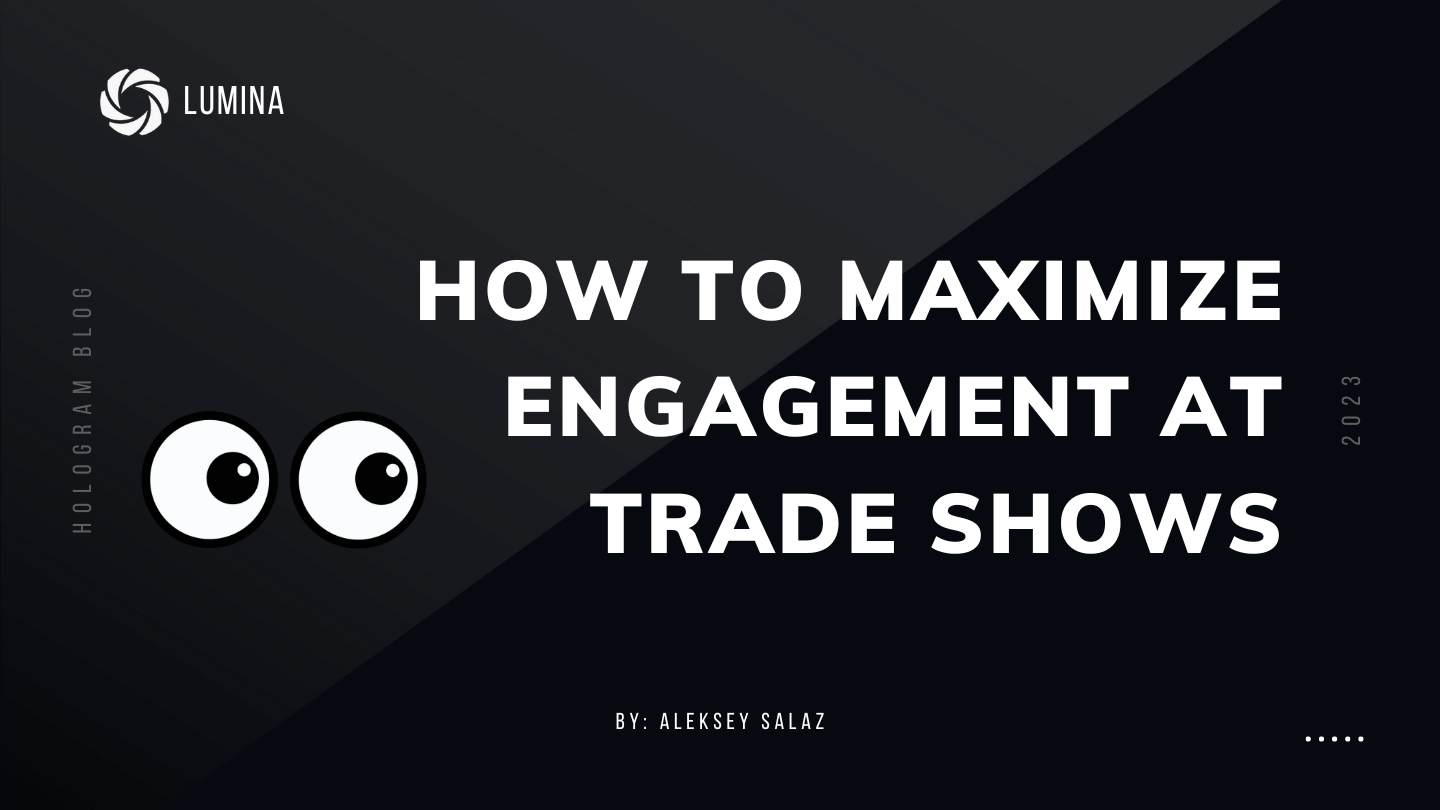What if your booth could be more than just tables and posters?
What if it could be a place where 3D images float in the air and every visitor feels like they're stepping into the future?
We're opening the doors to the secrets of making your booth the talk of the show. Get ready to learn how holograms and cool tech can turn your next trade show into an unforgettable adventure.
Are you ready to see how?
Here's a quick summary of the topics that will be covered:
- Introduction to Trade Show Advertising
- What is Trade Show Marketing?
- Preparing for Trade Shows
- The Evolution of Trade Show Marketing Methods
- Holographic Displays: A New Frontier
- The Wow-Factor: Holographic Fans
- How to Maximize Engagement at Trade Shows
- Follow-Up Strategies Post-Trade Show
- Trade Show Advertising: Different Ways to Stand Out
- Implementing Holographic Fans in Your Trade Show Advertising
- Maximizing Trade Show Impact
- Conclusion on Holographic Fans in Trade Show Advertising
- Frequently Asked Questions
What is Trade Show Marketing?
Definition and Overview
Trade show marketing is about promoting your products and services at large events. These events, called trade shows, are specially for businesses in a certain industry.
They are a great way to let more people know about your brand. At a trade show, you can set up a booth to show off what your company does and meet new customers.
Benefits of Trade Show Marketing
One big reason to take part in trade shows is to get your brand known. You can meet face-to-face with people interested in your products. It’s also a chance to see what your competitors are doing.
This can give you new ideas for your business. Plus, trade shows are perfect for networking and making important business connections.
How Trade Shows Boost Business
By being at a trade show, you can really help your business grow. You get to talk to people who might want to buy what you offer. This direct interaction can lead to more sales and long-term customers.
Also, getting feedback from people at the show can help you make your products even better.
Preparing for Trade Shows
1. Setting Clear Goals
Before you go to a trade show, decide what you want to achieve. Do you want to sell products, find business partners, or get emails for your mailing list? Having clear goals helps you focus and measure your success after the event.
2. Choosing the Right Trade Show
Pick a trade show that matches what your business offers. If you sell tech gadgets, a technology trade show is a good fit. This ensures you meet the right people who are interested in your products or services.
3. Preparing Your Booth
Your booth is where you’ll show off your business. Make sure it stands out and tells your brand's story. Have things like business cards, free samples, and eye-catching displays ready.
Pro tip: A well-prepared booth can attract more visitors and make a lasting impression. More about this later.
4. Training Your Team
Your booth staff should know your products well and be friendly to visitors. They play a big part in how people see your brand. Train them to answer questions and engage with people who stop by your booth.
Pro tip: Salespeople perform the best at trade show booths. More on this later.
5. Marketing Before the Show
Start telling people about your trade show participation before the event. Use social media, emails, and your website to create excitement. This can attract more people to your booth during the show.
How to Maximize Engagement at Trade Shows
Strategic Booth Design and Layout
Maximizing engagement at trade shows starts with strategic booth design. A well-planned layout that's open and inviting can significantly increase foot traffic. Incorporate interactive elements like touch screens, demo stations, or holographic displays to encourage visitor participation.
Pro tip: Ensure that your booth is visually appealing and reflects your brand's image and message clearly.
Utilizing Technology for Enhanced Interaction
Leverage the latest technologies to create a more engaging experience. Use holographic fans, VR, or AR to showcase your products in a unique and interactive way.
These technologies not only draw attention but also provide an immersive experience that can leave a lasting impression on attendees.
Effective Use of Promotional Materials
While digital technology is essential, don't overlook the power of traditional promotional materials. High-quality brochures, product samples, and branded giveaways can complement your digital efforts.

These tangible items can continue to remind attendees of your brand long after the trade show ends.
Training Staff for Active Engagement
Your booth staff plays a crucial role in engagement. Ensure they are well-trained and knowledgeable about your products and services.
Who Should Staff Your Booth?
A recent study shows that 59% of marketers believe salespeople are the best choice for staffing trade show booths, compared to 41% who favor other types of staff.
Pro tip: They should be approachable, proactive in starting conversations, and skilled at capturing and holding the attention of visitors.
Follow-Up Strategies Post-Trade Show
Engagement shouldn't end when the trade show does. Develop a follow-up strategy to maintain the connection with the leads you've gathered. This could include personalized emails, social media interactions, or phone calls.
Pro tip: Timely and relevant follow-up can turn a casual booth visit into a long-term business relationship.
Trade Show Advertising: A Few Different Ways to Stand Out
Leveraging Unique Themes and Storytelling
To stand out in trade show advertising, embrace unique themes and storytelling in your booth design.
Create a narrative that aligns with your brand identity and resonates with your target audience. This approach not only attracts attention but also makes your brand more memorable.
Interactive and Personalized Experiences
Offer interactive and personalized experiences to visitors. Use technology like touch screens, holographic displays, or even augmented reality to create customized experiences.

For instance, visitors could interact with a holographic version of your product, tailored to their preferences or interests.
Hosting Live Demonstrations and Events
Live demonstrations or events can be a huge draw. Whether it's a product demonstration, a mini-seminar, or a Q&A session with experts, these live events can increase engagement and give visitors a deeper understanding of your products or services.
Effective Use of Social Media and Online Platforms
Integrate your trade show presence with social media and online platforms. Encourage visitors to share their experiences at your booth on social media, perhaps by creating photo opportunities or shareable digital content.

This not only amplifies your presence at the trade show but also extends your reach to a wider online audience.
Creating a Buzz with Pre-Show Marketing
Start engaging with your audience before the trade show even begins. Use email marketing, social media, and other channels to tease your presence at the show.
Pro tip: Share sneak peeks of what to expect at your booth, and create a sense of anticipation and excitement.
Post-Trade Show Strategies
1. Quick Follow-Up with Contacts
After the trade show, reach out to the people you met. Send emails within a few days to remind them of your business. Make your message personal by mentioning something you talked about at the show. This helps people remember you and what your business offers.
2. Analyze Your Results
Look at how well you met your goals. Count how many new contacts you made, sales you closed, or how much interest there was in your products. Understanding what worked and what didn’t helps you do better at future trade shows.
3. Share Your Experience on Social Media
Post photos and stories from the trade show on your social media. This shows people who couldn’t make it what they missed. It’s also a great way to keep the conversation going with those who visited your booth.
4. Plan for the Next Steps
Think about the next steps for your new contacts. Do you want to schedule meetings, send more information, or offer special deals? Having a plan helps you turn these contacts into customers.
5. Get Feedback from Your Team
Talk to your staff about their experience. What did they think went well? What could be improved? Their feedback is valuable for making future trade shows even more successful.
The Evolution of Trade Show Marketing Methods
From Traditional to Digital
Trade show advertising has evolved significantly from its traditional roots. Initially, it was all about physical banners, brochures, and static displays. These methods, effective in their era, provided limited engagement.

As technology advanced, digital displays and interactive kiosks began to replace these traditional methods. This shift brought more dynamic and engaging ways to capture audience attention at trade shows.
The Rise of Interactive and Immersive Technologies
In recent years, trade show advertising has witnessed a surge in the use of interactive technologies. These include virtual reality (VR), augmented reality (AR), and of course, holographic displays.
These technologies provide immersive experiences, making it possible for businesses to not only showcase their products but also to create memorable experiences that resonate with attendees long after the event.
Holographic Displays: A New Frontier
Holographic displays represent the latest frontier in trade show advertising. They offer a unique combination of visual appeal and interactivity, taking audience engagement to a whole new level.

Unlike traditional or even other digital methods, holographic displays create 3D visuals that appear to float in mid-air, captivating audiences and providing an unparalleled platform for showcasing products and services.
Implementing Holographic Fans in Your Trade Show Advertising
Understanding Your Audience and Objectives
Before implementing holographic fans, it's essential to understand your audience and what you aim to achieve.
Are you looking to showcase a new product, strengthen brand recognition, or provide an educational experience? Tailor the holographic content to align with these objectives and resonate with your target audience.
Choosing the Right Content for Holographic Displays
The content displayed on holographic fans should be visually appealing and relevant to your brand. It can range from simple rotating logos to complex 3D models of your products. The key is to create content that captures attention and effectively conveys your message.
Integrating Holographic Fans with Overall Booth Design
Holographic fans should complement your overall booth design. Position them strategically to maximize visibility and impact. Ensure they are accessible and viewable from different angles, and consider how they fit into the flow and layout of your booth.
Technical Considerations and Setup
Pay attention to technical aspects like power requirements, mounting options, and space needed for optimal viewing.
Pro tip: Work with professionals who can assist in setting up and maintaining the holographic fans throughout the trade show to ensure they operate smoothly.
Measuring Impact and Gathering Feedback
After the trade show, assess the impact of the holographic fans. Gather feedback from attendees and analyze metrics like booth foot traffic, engagement time, and lead generation.
Pro tip: This data can help you refine your approach for future events and maximize the return on your investment.
Maximizing Trade Show Impact
Engaging Booth Design
Make your booth stand out with a design that catches the eye. Use bright colors, interesting graphics, or even interactive elements. Your booth should reflect your brand’s personality and make people want to stop and learn more.
Interactive Experiences
Create hands-on experiences at your booth. This could be a demo of your product, a fun game, or a virtual reality experience. Interactive elements can make your booth more memorable and encourage people to spend more time learning about your offerings.
Live Demonstrations and Events
Consider having live demonstrations or talks at your booth. This can draw a crowd and provide an opportunity to showcase your products or expertise in a dynamic way. Live events create excitement and can be a big draw for attendees.
Utilizing Technology
Use the latest technology to enhance your booth. This might include digital displays, holographic fans, or augmented reality. Technology can help convey your message in a modern, engaging way.
Networking and Building Relationships
Trade shows aren’t just about selling products, they’re also about building relationships. Spend time networking with other exhibitors and attendees. These connections can lead to valuable partnerships and opportunities in the future.
Effective Use of Social Media
Use social media to promote your presence at the trade show. Post updates, photos, and live videos to engage with both attendees and those who couldn’t make it. Encourage visitors to share their experiences at your booth on their social channels.
Conclusion
In conclusion, holographic fans are revolutionizing trade show advertising. They offer a unique way to engage and impress audiences. This technology goes beyond traditional methods, creating immersive and memorable experiences.
For businesses looking to stand out, embracing these innovative displays is key. Holographic fans are not just a trend; they represent the future of engaging, impactful trade show advertising.
Ready to Illuminate Your Trade Show Presence?
Contact Lumina today to explore how our holographic fan solutions can transform your next trade show experience. Let's create something unforgettable together.
Frequently Asked Questions
How do I advertise my trade show booth?
To advertise your trade show booth, utilize a mix of pre-show and during-show marketing strategies. This includes social media announcements, email campaigns, engaging booth design, interactive displays like holographic fans, and live demonstrations. It's crucial to create a buzz before the event and maintain engagement during the show.
Are trade shows a good way of marketing?
Yes, trade shows are an effective marketing tool. They offer a unique platform for face-to-face interactions with a targeted audience, allow for real-time feedback, and provide opportunities for live demonstrations and networking. Trade shows can significantly boost brand awareness and lead generation.
How to do trade show marketing?
Trade show marketing involves strategic planning and execution. It includes defining your goals, understanding your audience, designing an engaging booth, utilizing interactive technologies, training staff for effective communication, and following up with leads post-event. The key is to create an experience that resonates with attendees.
What kind of advertising involves your events and trade shows?
Advertising for events and trade shows typically involves digital marketing (social media, email campaigns, online ads), print materials (brochures, flyers), PR activities, and collaborations with influencers or industry partners. The aim is to maximize visibility and attract attendees to your event or booth.
How does trade advertising work?
Trade advertising works by targeting industry-specific audiences, usually through B2B channels. It focuses on showcasing products or services to businesses, distributors, and retailers within a particular sector. This can include advertising in trade publications, at trade shows, and through direct B2B marketing efforts.
What does trade advertising include?
Trade advertising includes various marketing activities aimed at industry professionals. This can involve print and digital ads in trade magazines, online platforms, participation in trade shows and exhibitions, direct email marketing, and networking events. The goal is to promote products or services to a business audience.
What are the 5 P's of trade marketing?
The 5 P's of trade marketing are Product, Price, Place, Promotion, and People. These elements involve ensuring the right products are offered at a competitive price, in the right places, with effective promotion strategies, and by engaging people (customers and staff) effectively in the process.
What type of promotion is trade shows?
Trade shows are a type of experiential promotion. They provide businesses with a platform to demonstrate products, interact with potential clients, and create a memorable brand experience. Trade shows combine elements of direct marketing, personal selling, and corporate events.
Are trade shows sales or marketing?
Trade shows encompass both sales and marketing. They serve as a marketing tool to increase brand awareness, generate leads, and build business relationships. Simultaneously, they offer opportunities for direct sales, negotiations, and closing deals with potential clients on the spot.


